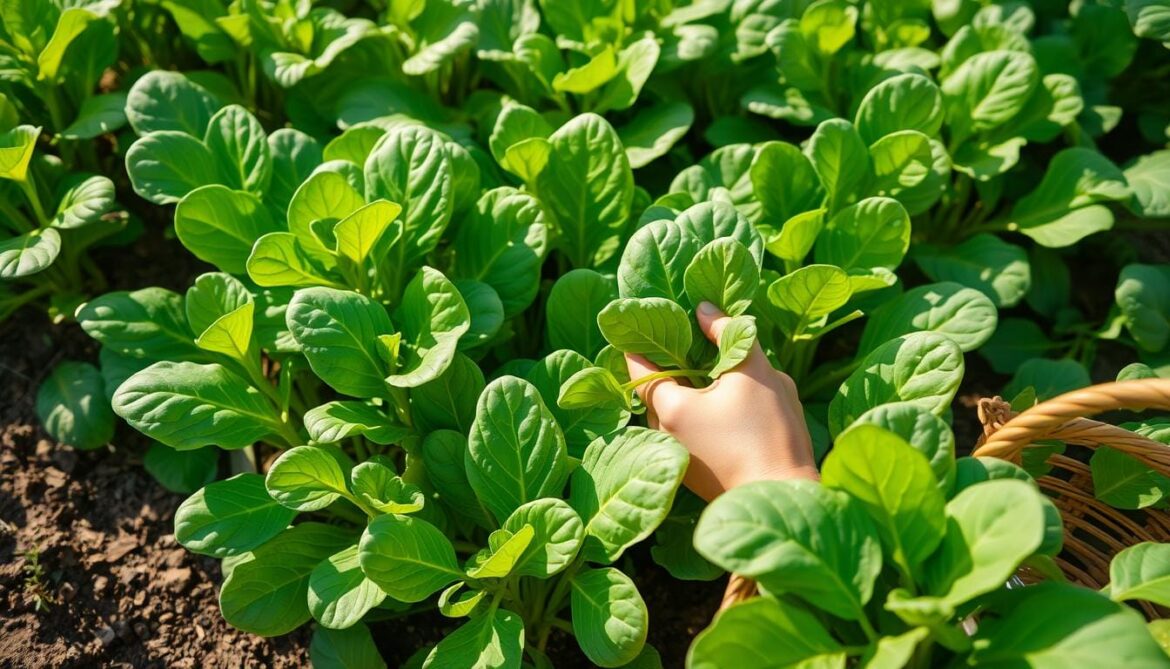Starting my spinach journey opened a world of green leaves and nutrition in my backyard. Harvesting spinach is more than a task—it’s an art that connects us to our food. This guide will show you how to harvest spinach, making your gardening experience rewarding.
Spinach is a great choice for gardeners because it’s packed with nutrients and can be picked several times. Whether you’re new to spinach or have experience, knowing how to harvest it right will make your crop taste better and grow more.
Key Takeaways
- Spinach can be harvested multiple times before bolting
- Optimal harvest time is when leaves reach 3-6 inches long
- Temperature plays a critical role in spinach growth and harvesting
- Baby spinach offers milder, more tender leaves
- Proper harvesting techniques ensure continued plant production
Understanding Spinach Growth Stages
Vegetable gardening fans know that knowing spinach’s growth stages is key. This journey shows how spinach changes from a tiny seed to a healthy leafy green.
Spinach is a cool-season crop that does well in certain conditions. Using crop rotation helps manage its growth and boosts yield.
Germination and Early Development
The spinach growth starts with careful seed planting. Seeds need the right conditions to grow:
- Optimal soil temperature: 70°F (21°C)
- Planting depth: ½ inch
- Seed germination time: 7-10 days
- Seedling stage duration: Approximately 7 days
Maturity Indicators
Tracking spinach’s growth helps gardeners know when to harvest. Here are the main growth stages:
| Growth Stage | Duration | Key Characteristics |
|---|---|---|
| Vegetative Growth | 28-42 days | Leaf development, plant reaches 6 inches |
| Flowering Stage | 14-21 days | Environmental triggered changes |
| Harvest Ready | 6-10 weeks | Leaves reach full size, ready for picking |
Pro tip: Watch for environmental cues like day length. Spinach may bolt when day lengths exceed 14 hours, signaling a shift in growth patterns.
“Understanding spinach’s growth stages is like reading a living blueprint of nature’s incredible design.” – Gardening Expert
Ideal Conditions for Harvesting Spinach
To grow spinach well, you need to know the right environmental conditions. We’ll look at how to create the best environment for these leafy greens. This will help them grow strong and full of nutrients.
Spinach loves environments that are carefully managed. The right mix of soil, temperature, and light can make a big difference in your harvest.
Critical Soil Requirements
Spinach needs certain soil conditions to grow well. Here’s what we suggest:
- Well-drained, fertile soil rich in organic matter
- Soil pH between 6.5 and 7.0
- Loose, nutrient-dense ground with good moisture retention
Temperature and Light Preferences
Knowing the right temperature range is key for growing spinach. Our research shows the best conditions:
| Temperature Range | Plant Response |
|---|---|
| 50-75°F (10-24°C) | Optimal growth conditions |
| Below 40°F | Slow growth, but plant survival |
| Above 80°F | Risk of bolting and reduced quality |
Light is also important for spinach. Partial shade during hot periods helps prevent early bolting and keeps leaves healthy.
Successful spinach cultivation is about creating a balanced microclimate that supports steady, healthy growth.
By using organic farming methods and sustainable practices, gardeners can improve their spinach production. This leads to more nutritious and abundant harvests.
Tools We Need for Harvesting Spinach
Harvesting seasonal produce like spinach needs the right tools. Our farm-to-table approach starts with picking the best tools for these leafy greens.
Choosing the right tools is key for a great gardening experience. You want tools that don’t hurt the plants and help you harvest more efficiently.
Essential Harvesting Tools
- Sharp Scissors: Perfect for cutting individual leaves with precision
- Harvest Basket or Container: Keeps leaves fresh and prevents bruising
- Clean, sharp garden knife for bigger harvests
- Gardening gloves to protect your hands and keep things clean
Optional Equipment for Enhanced Harvesting
For those wanting to improve their harvesting, here are some extra tools:
- Lightweight pruning shears
- Portable harvest apron with lots of pockets
- Garden cart or wheelbarrow for bigger gardens
“The right tool can turn harvesting into a fun garden activity.”
Start with basic tools and add more as you get better at growing spinach. Remember, gentle handling keeps the leaves fresh and crisp, which is key for the farm-to-table movement.
Timing Our Harvest
Harvesting spinach is an art that needs careful timing and knowing the plant’s growth cycle. It’s important to harvest at the right time for the best taste, nutrition, and yield.
Several factors are important when planning to harvest spinach. The plant’s growth stage and the season greatly affect the quality and amount of your spinach.
Early Harvest vs. Mature Leaves
We have different options for harvesting spinach leaves:
- Microgreens: Ready 7-14 days after sowing
- Baby spinach: Harvestable 20-35 days after planting
- Mature spinach: Fully developed around 45-50 days
Baby spinach has a tender texture and sweeter flavor. It’s best to pick no more than a fourth of the plant’s leaves at once. This helps the plant keep growing.
Seasonal Considerations
| Season | Harvest Characteristics |
|---|---|
| Spring | Optimal growing conditions, cool temperatures |
| Summer | Risk of bolting above 75°F, shorter harvest window |
| Fall | Extended harvest period, cooler temperatures |
“The key to successful spinach harvesting is understanding its relationship with temperature and daylight.” – Agricultural Expert
To keep harvesting spinach, plant every two weeks. This way, you’ll have a steady supply of fresh spinach all season. Harvest in the morning or evening to avoid heat stress and keep the leaves fresh.
Techniques for Harvesting Spinach
Learning how to harvest spinach is key in leafy greens farming. Our organic farming methods aim to boost plant growth and keep farming sustainable.
Spinach can be harvested in several ways, fitting different garden sizes and goals. Knowing these methods helps gardeners get the most from their crops.
Hand Harvesting Methods
Hand harvesting is the most accurate way to pick spinach leaves. Here’s how we suggest doing it:
- Select leaves that are 4-6 inches tall
- Cut leaves near the stem’s base
- Leave about 2/3 of the plant to grow more
Tool-Based Harvesting
For bigger gardens, using tools can make harvesting easier. Here are some tools to consider:
| Tool | Efficiency | Best Use |
|---|---|---|
| Garden Scissors | High Precision | Small to Medium Gardens |
| Harvesting Knife | Quick Cutting | Large Commercial Plots |
| Pruning Shears | Versatile | Mixed Garden Environments |
“Harvest with care, and your spinach will reward you with continuous growth.” – Gardening Wisdom
Using these organic farming methods helps spinach grow strong and healthy. Harvest in the morning or evening to avoid wilting and keep leaves fresh.
Our harvesting methods help spinach grow back quickly. With proper care, spinach can produce new leaves in just days, giving you multiple harvests from one planting.
Best Practices for Harvesting Spinach
When you garden with sustainable practices, harvesting spinach is key. It needs careful attention to grow well and get a good yield. We focus on keeping the leaves healthy and intact.
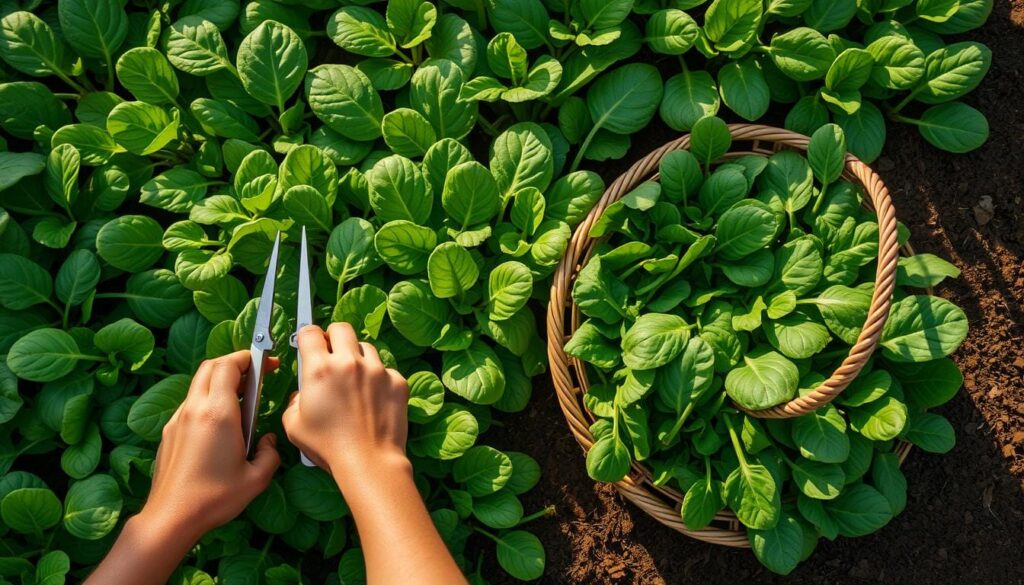
Knowing how spinach grows and using gentle methods is vital. We’ll show you the best ways to harvest without harming the plants.
Protecting Your Spinach Plants
Experts say a few things to avoid damaging your spinach:
- Use clean, sharp scissors or garden shears
- Cut leaves carefully at the base
- Harvest only 1/3 of each plant to encourage regrowth
- Avoid pulling or yanking leaves
Making Clean and Precise Cuts
To keep your garden healthy, follow these cutting tips:
- Select mature leaves first, leaving younger leaves to continue growing
- Cut just above the plant’s crown
- Make smooth, quick cuts to prevent plant stress
- Sanitize tools before and after harvesting
| Harvesting Technique | Recommended Practice |
|---|---|
| Cutting Method | Scissor/Sharp Tool |
| Harvest Amount | 1/3 of Plant |
| Best Time | Morning or Evening |
| Tool Preparation | Clean and Sterilized |
“Gentle harvesting ensures continued plant productivity and healthy spinach growth.”
Remember, successful vegetable gardening is about understanding and respecting your plants’ natural growth cycles.
How to Store Freshly Harvested Spinach
Keeping your spinach fresh is key in the farm-to-table movement. After picking your seasonal produce, storing it right is vital. This helps keep its nutritional value and taste.
Fresh spinach needs special care to last longer. The best storage temperature is between 32° and 40°F. It should be kept in about 95% humidity. With the right handling, your spinach can stay fresh for up to 10 days.
Short-Term Storage Solutions
- Wrap spinach leaves in slightly damp paper towels
- Place in an airtight container
- Store in the refrigerator’s crisper drawer
- Avoid storing near ethylene-producing fruits like apples and bananas
Long-Term Preservation Methods
For longer storage, try these methods:
- Freezing: Blanch spinach for 2-3 minutes, then cool it in ice water
- Pat dry and pack in freezer-safe containers
- Frozen spinach can be stored up to one year
- Use frozen spinach directly in soups and sauces
“Proper storage is the key to maintaining the nutritional integrity of your home-grown spinach.”
Watch for signs of spoilage like wilting, discoloration, or bad smells. By using these storage tips, you can enjoy your spinach for weeks.
Signs of Spinach Ready for Harvest
Knowing when to harvest spinach is key to getting the best taste and nutrition. Picking spinach at the right time means you get the most flavor and health benefits. This is true for both common and heirloom spinach types.
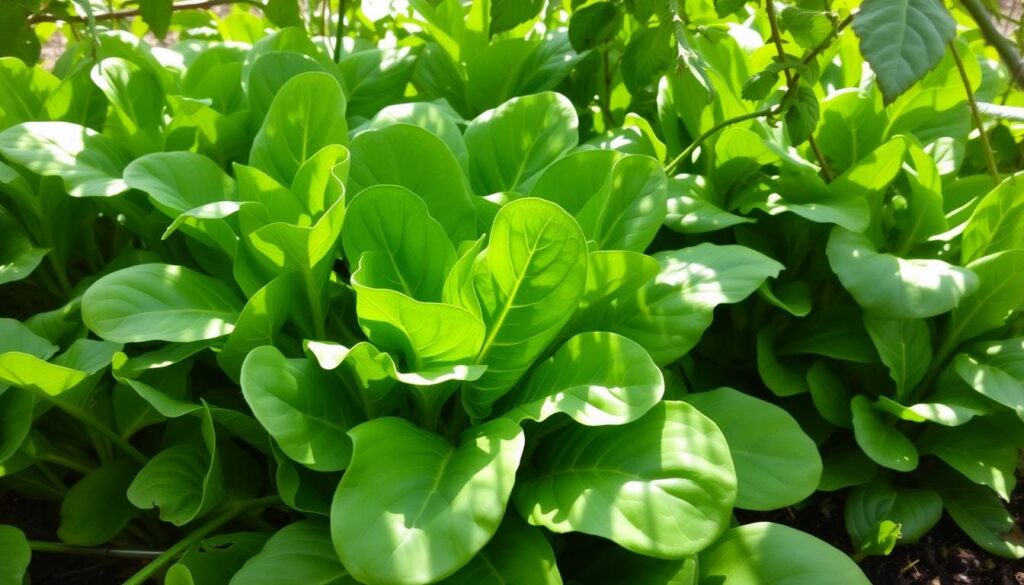
To harvest spinach well, you need to know certain signs. These signs tell you when your spinach is ready to be picked.
Leaf Size and Color Indicators
When you’re ready to harvest spinach, look for these important signs:
- Leaf length should be around 6 inches
- Color should be deep, vibrant green
- Avoid leaves turning yellow or showing signs of aging
Texture and Firmness Assessment
The feel of spinach leaves is also important for knowing when to harvest:
| Texture Stage | Harvest Recommendation |
|---|---|
| Baby Spinach | Leaves size of a U.S. quarter (20-30 days) |
| Mature Spinach | Leaves between 38-50 days after sowing |
| Aging Spinach | Pointed leaf tips indicate reduced flavor |
“The secret to perfect spinach is catching it at its peak of perfection.” – Gardening Wisdom
For heirloom spinach, the harvest time might be different. Watch each plant’s unique growth to find the best time to pick.
You can usually harvest spinach in 2-3 rounds before it’s fully grown. By picking the bigger leaves first, you help the plant grow more from the center.
Common Mistakes When Harvesting Spinach
Spinach cultivation needs careful attention. Growing spinach can be rewarding but comes with challenges. Knowing these challenges helps ensure a successful harvest.
Recognizing Over-Harvesting Challenges
One big mistake is over-harvesting spinach. Removing too many leaves can stress plants and lower yield. Experts say to only take about one-third of the leaves at a time to keep plants healthy.
- Remove no more than 1/3 of plant leaves per harvest
- Allow plants time to regenerate between harvesting
- Monitor plant stress and growth patterns
Weather Considerations During Harvest
Weather affects spinach quality a lot. Temperature is key for leaf growth and taste. When it gets too hot, spinach can bolt, changing its texture and taste.
| Temperature Range | Spinach Response |
|---|---|
| 50-60°F | Optimal Growing Conditions |
| Above 75°F | High Risk of Bolting |
| Below 40°F | Slow Growth, Possible Damage |
Pro tip: Harvest spinach early in the morning when it’s cooler to keep leaves fresh and prevent stress.
“Understanding your plants’ environmental needs is key to successful spinach cultivation.” – Sustainable Gardening Expert
Handling Pests and Diseases
Growing spinach needs careful watch against pests and diseases. Our organic farming methods aim to prevent and manage crop health sustainably.
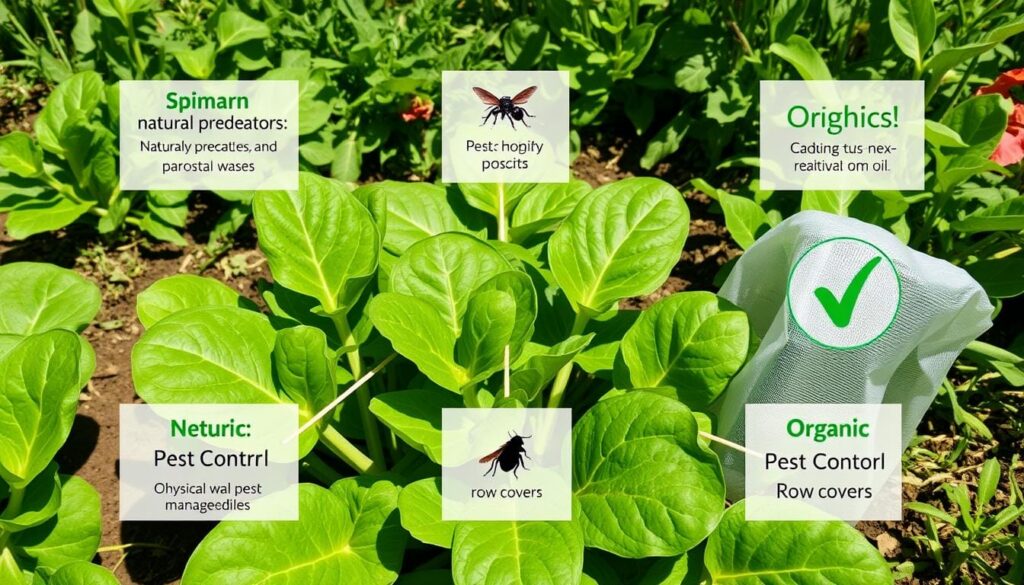
Knowing common pests that harm spinach is key to a healthy garden. These pests can ruin your harvest if not stopped.
Common Spinach Pests to Watch
- Aphids: Tiny insects that can cause leaf yellowing and stunted growth
- Leaf miners: Creating meandering trails on spinach leaves
- Slugs and snails: Leaving large holes and distinctive slime trails
- Flea beetles: Producing small “shotgun blast” holes in foliage
- Cutworms: Damaging young plants at the soil level
Preventive Strategies for Pest Control
We suggest organic ways to control pests in your spinach garden. Natural pest management techniques help avoid chemical use.
| Pest | Control Method | Effectiveness |
|---|---|---|
| Aphids | Manual pruning, neem oil | High |
| Leaf Miners | Remove infected leaves | Medium |
| Slugs/Snails | Diatomaceous earth barriers | High |
Pro tip: Regularly check your plants and keep your garden clean to stop pests early.
Prevention is always better than cure in organic vegetable gardening.
By using these methods, we can keep our spinach safe and ensure a healthy harvest. We do this with sustainable, eco-friendly practices.
Nutritional Benefits of Spinach
Spinach is a nutritional powerhouse in leafy greens farming. It offers many health benefits, making it a key part of the farm-to-table movement. Let’s dive into why spinach is so good for us.
Spinach is packed with nutrients. It gives us amazing health benefits:
- Contains nearly 2.9 grams of protein per 100 grams
- Provides over 50% of recommended daily Vitamin K1
- Rich in essential minerals like iron, calcium, and potassium
Why We Should Love Spinach
Spinach has many health benefits. It’s not just about nutrition. Studies show women with more lutein in their diet are 23% less likely to get cataracts.
Its antioxidants fight oxidative stress. This could lower the risk of prostate and breast cancer.
“Let food be thy medicine” – This ancient wisdom perfectly describes spinach’s nutritional power.
Other Uses for Spinach
Spinach is not just for cooking. It’s great for gardening and natural dyeing. The farm-to-table movement loves spinach for its sustainability and versatility.
With only 7 calories per cup and no fat, spinach is perfect for healthy diets. It’s low in calories but high in nutrients, making it a top choice in leafy greens farming.
How to Extend Harvest Season
Gardening lovers know the joy of fresh produce doesn’t have to end with summer’s close. Our strategies for extending the spinach harvest season combine crop rotation and sustainable agriculture practices. This keeps your garden productive longer.
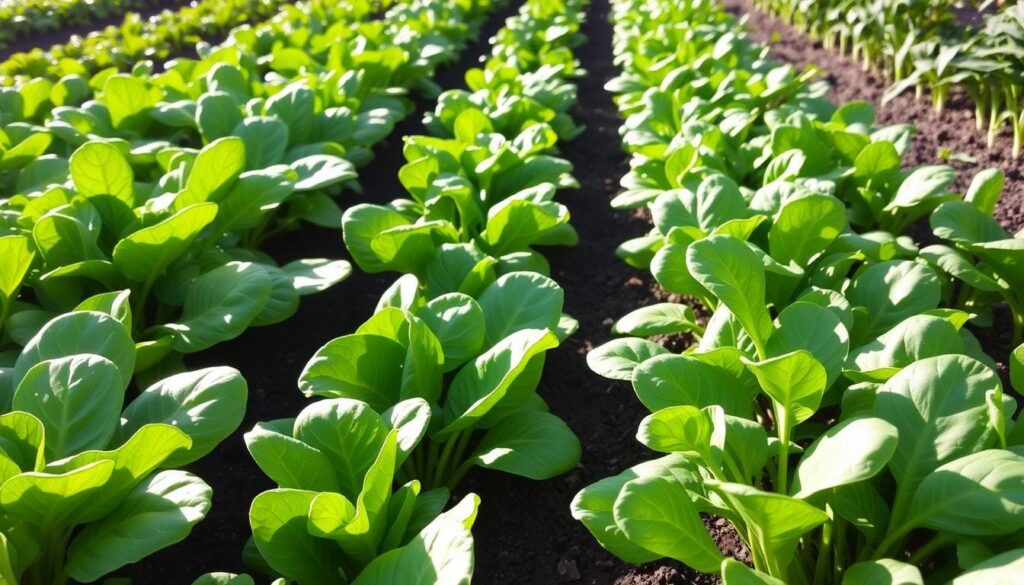
Successful vegetable gardening requires strategic planning. We can maximize our spinach yield through intelligent planting techniques that work with nature’s rhythms.
Succession Planting Strategies
Succession planting allows continuous spinach harvests by implementing smart scheduling. Here are key approaches:
- Plant new spinach seeds every 2-3 weeks
- Start fall crops in early August
- Use cold-hardy spinach varieties
- Protect plants with row covers
Companion Planting and Crop Rotation
Sustainable agriculture practices like companion planting and crop rotation can dramatically improve spinach production. By rotating spinach with other vegetables, we reduce soil nutrient depletion and minimize pest problems.
| Companion Plants | Benefits |
|---|---|
| Strawberries | Improve soil health |
| Peas | Nitrogen fixation |
| Radishes | Pest deterrence |
“The secret to a bountiful garden is understanding plant relationships and working with natural cycles.” – Experienced Gardener
With careful planning, we can enjoy fresh spinach well into autumn. This transforms our garden into a sustainable, productive ecosystem.
Recipes to Use Our Harvested Spinach
Our farm-to-table movement celebrates the joy of seasonal produce harvesting. We turn freshly picked spinach into delicious dishes. Home gardeners can make their meals more exciting by using their own spinach in various recipes.
Quick and Easy Spinach Dishes
Fresh spinach is very versatile in cooking. Here are some simple yet tasty ways to enjoy your harvest:
- Garlicky Roasted Prawns with Spinach
- Preparation time: 20 minutes
- Cooking time: 10 minutes
- Uses 4-5 cups of fresh spinach leaves
- Chickpea and Spinach Soup
- Preparation time: 15 minutes
- Cooking time: 16-17 minutes
- Incorporates 2 cups of fresh spinach leaves
Creative Ways to Incorporate Spinach
Try these innovative spinach recipes to expand your cooking skills:
| Recipe | Serving Size | Nutritional Highlights |
|---|---|---|
| Harvest Spinach and Apple Chicken Salad | 1/2 recipe |
|
“Fresh spinach transforms ordinary meals into extraordinary culinary experiences!” – Home Gardening Magazine
Pro tip: Add spinach to dishes in the last cooking stages. This keeps its color and nutrients. Thickly sliced spinach is great in soups, stews, curries, stir-fries, and casseroles.
Keep your spinach fresh by storing it in a plastic bag in the fridge’s crisper for three to four days. To clean, use cold water and gently swirl. The leaves will float, and the dirt will sink.
Engaging Kids in Spinach Harvesting
Vegetable gardening is a great way to connect kids with nature and teach them about sustainable farming. It turns growing spinach into a fun adventure.
Children love to get their hands dirty. Spinach is perfect for them to learn about plants and healthy eating.
Fun Activities to Spark Garden Excitement
- Create a Spinach Crown using freshly harvested leaves
- Design a weekly growth tracking chart
- Plant different spinach varieties to compare growth rates
- Use fun-shaped cookie cutters for leaf tracing
Educational Gardening Experiences
Learning where food comes from is key to sustainable farming. By letting kids help with harvesting, we teach them about nutrition and caring for plants.
| Activity | Learning Outcome |
|---|---|
| Harvesting Outer Leaves | Fine Motor Skills Development |
| Keeping a Garden Journal | Documenting Growth Observations |
| Preparing Spinach Dishes | Nutritional Awareness |
“Gardening is a great way to unplug and connect with nature” – Gardening Experts
Make spinach harvesting exciting by showing its health benefits. Kids are more likely to eat veggies they’ve grown.
Final Thoughts on Harvesting Spinach
Our journey into harvesting spinach shows the power of organic farming for home gardeners. Spinach grows fast and can be picked many times. It turns small gardens into a source of healthy food.
Learning to harvest spinach takes time and effort. We’ve found that knowing what plants need is key. This includes the right space, sunlight, and water. You can harvest spinach leaves 3 to 4 times, making it a sustainable choice for gardeners.
Encouragement for Home Gardeners
Our journey shows anyone can grow spinach successfully. With simple steps like planting in succession and watching your plants, you can have fresh greens all season. The joy of eating what you grow is worth the learning process of organic farming.
Inviting Feedback and Experiences
We want to hear your stories and tips on growing spinach. Your experiences can help others grow better. Whether you’re new or experienced, your insights are valuable to us all.
